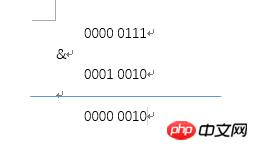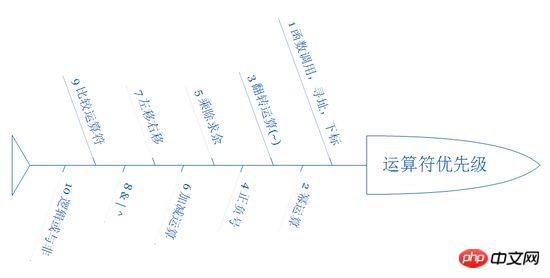Python operators and control flow
Operators in Python
What are operators? Take a simple example 4 +5 = 9. In the example, 4 and 5 are called operands, and "+" is called the operator.
1. Exponentiation operator
In Java, if we want to exponentiate a number, we may have to resort to pow() in the Math library function, but in Python we can use two consecutive * to represent the exponentiation operation.
a = 5 ** 2 print a
2 . // Operator
Many people may want to say, I know this, I type Comments often use double slashes, but it is very embarrassing. The single-line comment symbol in Python is #, and multi-line comments can use '''. So what is // used for? Used to find the integer part of dividing two numbers.
a = 10.0 // 3 print a
At this time, 3.0 will be output, which is the integer part of the division, and the remainder will be ignored.
3. &, | Operator
Everyone knows these two operators, & bitwise AND, | bitwise OR, let’s talk about these two operators The operating principle of each operator. How much does a number 7&18 equal? Try running it in the compiler
a = 7 & 18 print a
The printed result is 2. why? It's very simple. We first need to convert 7 and 18 into binary, 7-> 00000111 18->00010010, and then perform an AND operation on these two binary numbers. What is the AND operation? Just remember that when the two numbers are both 1 in the same position, the result is 1, and the other numbers are 0. The operation process is as follows

It is obvious that the result is 2. The | operator is the same as the & operation steps. However, during the | operation process, as long as the two numbers are at the same position, If one is 1, then the result is 1. You can calculate it yourself, so I won’t go into details here.
4 . >>,<< Operator
When I first saw this symbol, my first reaction was that it is far greater than and far Far less than, does this mean right shift and left shift, left shift and right shift? How to move? Similarly, you need to convert the decimal number into binary form, and then shift left and right. In fact, shifting left once is equivalent to multiplying a number by 2, shifting left n times is multiplying a number by 2 n times, and shifting right Instead, it is divided by 2 raised to the 'n' power.
# coding=utf-8 # 左移2位 a = 5 << 2 print a # 右移三位 b = 32 >> 3 print b
5 . not, and, or operators
These three are logical operators, in other If you want to express OR and NOT in a programming language, you might use the format ||,&&,!, but in Python you need to use or,and,not.
a = True b = False c = not a d = a and b e = a or b print c print d print e
The results are False False True
6. We will not introduce the operators, but let’s take a look at the precedence of the operators. , I made a picture

The closer to the fish head, the higher the level.
Python control flow
The so-called control flow is nothing more than if..else, while, for, etc. Everyone knows the basic usage, but Python always has its special features. Let’s take a look.
1 . if...else
if judgment statement has a place worth introducing, as shown below
a = 10 if 5 <= a <= 10: print a
In Java language, you probably have to write like this
int a = 10;
if(a >= 5 && a <= 10){
System.out.println(a);
}2 . while , for
The only thing you need to remember is that in Python, whether it is for or while, you can add an else statement at the end like if. The else statement will be executed after the loop statement jumps out.
a = False
while a:
print ("I am while")
else:
print ("I am else")
for i in range(1, 2):
print ("I am for")
else:
print ("I am else")Tips: range() The function can set the step interval, what does it mean? Try it yourself~
Summary
The above is all about operators and control flow in Python, what this article talks about It is basic introductory knowledge, but it is also a very important part. I hope it will be helpful to everyone in using Python.
For more articles related to Python’s operators and control flow, please pay attention to the PHP Chinese website!

Hot AI Tools

Undresser.AI Undress
AI-powered app for creating realistic nude photos

AI Clothes Remover
Online AI tool for removing clothes from photos.

Undress AI Tool
Undress images for free

Clothoff.io
AI clothes remover

Video Face Swap
Swap faces in any video effortlessly with our completely free AI face swap tool!

Hot Article

Hot Tools

Notepad++7.3.1
Easy-to-use and free code editor

SublimeText3 Chinese version
Chinese version, very easy to use

Zend Studio 13.0.1
Powerful PHP integrated development environment

Dreamweaver CS6
Visual web development tools

SublimeText3 Mac version
God-level code editing software (SublimeText3)

Hot Topics
 1662
1662
 14
14
 1419
1419
 52
52
 1313
1313
 25
25
 1262
1262
 29
29
 1236
1236
 24
24
 Python vs. C : Applications and Use Cases Compared
Apr 12, 2025 am 12:01 AM
Python vs. C : Applications and Use Cases Compared
Apr 12, 2025 am 12:01 AM
Python is suitable for data science, web development and automation tasks, while C is suitable for system programming, game development and embedded systems. Python is known for its simplicity and powerful ecosystem, while C is known for its high performance and underlying control capabilities.
 The 2-Hour Python Plan: A Realistic Approach
Apr 11, 2025 am 12:04 AM
The 2-Hour Python Plan: A Realistic Approach
Apr 11, 2025 am 12:04 AM
You can learn basic programming concepts and skills of Python within 2 hours. 1. Learn variables and data types, 2. Master control flow (conditional statements and loops), 3. Understand the definition and use of functions, 4. Quickly get started with Python programming through simple examples and code snippets.
 Python: Games, GUIs, and More
Apr 13, 2025 am 12:14 AM
Python: Games, GUIs, and More
Apr 13, 2025 am 12:14 AM
Python excels in gaming and GUI development. 1) Game development uses Pygame, providing drawing, audio and other functions, which are suitable for creating 2D games. 2) GUI development can choose Tkinter or PyQt. Tkinter is simple and easy to use, PyQt has rich functions and is suitable for professional development.
 How Much Python Can You Learn in 2 Hours?
Apr 09, 2025 pm 04:33 PM
How Much Python Can You Learn in 2 Hours?
Apr 09, 2025 pm 04:33 PM
You can learn the basics of Python within two hours. 1. Learn variables and data types, 2. Master control structures such as if statements and loops, 3. Understand the definition and use of functions. These will help you start writing simple Python programs.
 Python vs. C : Learning Curves and Ease of Use
Apr 19, 2025 am 12:20 AM
Python vs. C : Learning Curves and Ease of Use
Apr 19, 2025 am 12:20 AM
Python is easier to learn and use, while C is more powerful but complex. 1. Python syntax is concise and suitable for beginners. Dynamic typing and automatic memory management make it easy to use, but may cause runtime errors. 2.C provides low-level control and advanced features, suitable for high-performance applications, but has a high learning threshold and requires manual memory and type safety management.
 Python and Time: Making the Most of Your Study Time
Apr 14, 2025 am 12:02 AM
Python and Time: Making the Most of Your Study Time
Apr 14, 2025 am 12:02 AM
To maximize the efficiency of learning Python in a limited time, you can use Python's datetime, time, and schedule modules. 1. The datetime module is used to record and plan learning time. 2. The time module helps to set study and rest time. 3. The schedule module automatically arranges weekly learning tasks.
 Python: Exploring Its Primary Applications
Apr 10, 2025 am 09:41 AM
Python: Exploring Its Primary Applications
Apr 10, 2025 am 09:41 AM
Python is widely used in the fields of web development, data science, machine learning, automation and scripting. 1) In web development, Django and Flask frameworks simplify the development process. 2) In the fields of data science and machine learning, NumPy, Pandas, Scikit-learn and TensorFlow libraries provide strong support. 3) In terms of automation and scripting, Python is suitable for tasks such as automated testing and system management.
 Python: Automation, Scripting, and Task Management
Apr 16, 2025 am 12:14 AM
Python: Automation, Scripting, and Task Management
Apr 16, 2025 am 12:14 AM
Python excels in automation, scripting, and task management. 1) Automation: File backup is realized through standard libraries such as os and shutil. 2) Script writing: Use the psutil library to monitor system resources. 3) Task management: Use the schedule library to schedule tasks. Python's ease of use and rich library support makes it the preferred tool in these areas.




